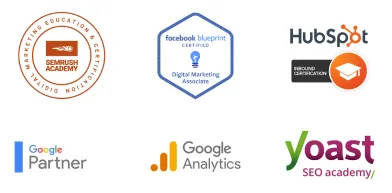TO LEARN IS TO GROW
Learning Center
We do our research and publish our results. Should probably call this the Growing Center.


How to Design a Mobile Friendly Website?
Creating a mobile-friendly website is not just about shrinking down its size to accommodate the smaller screen. It should also be responsive, fast-loading, and easy-to-navigate.
The mobile device is a key part of modern life, with around 67% of the world population relying on this communication gadget. Hence, it is not surprising that it now accounts for about 90% of the global Internet usage, according to a recent Statistica survey.
With mobile users accounting for the vast majority of Internet searches and social media use, businesses should ensure that their websites are mobile-friendly.
What Is a Mobile-Friendly Website?
Contrary to popular belief, creating a mobile-friendly website is not just about shrinking down its size to accommodate the smaller screen. Several factors also come into play that will determine whether the site provides an excellent user experience.
(Note: A few weeks ago, Google released the first wave of algorithm updates that further give importance to page experience and mobile-friendliness.)
Leading digital marketing expert LOJO Marketing shares some tips on how to design a mobile-friendly website.
Create content in which the key information is easy to find
Consumers use keywords and phrases to know something about a product or service, or if they have a problem or pain point that needs to be solved. For this reason, make sure that your website “speaks” their language and provides complete information such as your location, operating hours, contact number, and product listing (and ideally with prices).
One of the most common mistakes of businesses using websites is that they only mention contact details on their “About Us” page instead of putting it on every web page in the most conspicuous place.
Surveys have shown that putting a contact number on websites can increase conversion rates and sales.
Create fast-loading websites
While the general best practice recommends that a site should at least load in 2 seconds, it doesn’t hurt to aim for a loading time under a second. Remember, mobile users are increasingly becoming impatient that according to a previous Google survey, more than half of them abandoned a site when the page took over three seconds to load.
If your site is putting off visitors, you may consider these tips:
Use compressed images; eliminate source-intensive graphics
Simplify your web design
Activate Google AMP
Avoid or at least use custom fonts to a minimum
Find a better host
Simplify your codes
Reduce the number of plugs; eliminate those with duplicate functionality
Use compressed content
Use cache
Simplify your signup forms
Eliminate intrusive ads and pop-ups
There is nothing more annoying than pop-ups that block the content you’re reading. Take note that today’s online users are impatient and less forgiving that instead of just finding the X to eliminate the ads on their view, they might just decide to find another site that is less intrusive.
If you really need to use pop-up blocks, make sure that they are not intrusive.
Allow mobile users to disable pop-up blocks.
Ensure that the X or cancel button is big enough to be easily seen.
Make sure that pop-ups only appear when the visitors have scrolled down the page.
Make a responsive website
In a nutshell, a responsive website automatically adjusts to different screens and viewports and maintains a visually presentable layout that promotes a good page experience. This can be achieved using responsive text and images (i.e., they can detect and adjust themselves depending on the screen size) and buttons that are large enough to be visible and conveniently clicked.
Ditch the flash
First and foremost, iOS and Android devices don’t support flash, which means that mobile users cannot access or see the content. And from an SEO perspective, it can also spell disaster because it slows down the loading speed and is not compatible with most browsers.
Most web designers no longer use flash; however, some older websites continue using this outdated technology that can ruin their search engine ranking.
Use a relatively large font size
With a decent-sized font, your visitors can easily understand the content and find the information they need. A good rule of thumb is to use a font size not smaller than 14px, and opt for a standard font design.
In contrast, avoid or minimize the use of a custom font, which can slow down your website.
Choose larger button sizes
To avoid “accidental clicks” and promote a good user experience, make sure that your mobile website has larger buttons that are positioned slightly far apart from each other.
Lean towards a minimalist website design
Web designing and home interior design have one thing in common: Too many visual elements result in clutter that distracts visitors and makes navigation difficult. This is particularly true when the web page is viewed from a smaller screen.
A good rule of thumb is to have fewer files and more compact content on each page. Not only this minimalist design will make it easier for visitors to find the information they need, it will also allow the website to load faster.
If your site really needs multiple categories and pages, you may want to whittle them down to the most important options on mobile screens.
Final Words About How to Design a Mobile Friendly Website
Once you have adopted all the aforementioned tips, don’t forget to conduct regular tests to ensure that your website provides a good page experience for mobile users. Pay close attention to the layout, the responsiveness of the buttons, the accessibility of “key information” (e.g., your contact information and address), and arguably the most important, the loading speed.

How to Design a Mobile Friendly Website?
Creating a mobile-friendly website is not just about shrinking down its size to accommodate the smaller screen. It should also be responsive, fast-loading, and easy-to-navigate.
The mobile device is a key part of modern life, with around 67% of the world population relying on this communication gadget. Hence, it is not surprising that it now accounts for about 90% of the global Internet usage, according to a recent Statistica survey.
With mobile users accounting for the vast majority of Internet searches and social media use, businesses should ensure that their websites are mobile-friendly.
What Is a Mobile-Friendly Website?
Contrary to popular belief, creating a mobile-friendly website is not just about shrinking down its size to accommodate the smaller screen. Several factors also come into play that will determine whether the site provides an excellent user experience.
(Note: A few weeks ago, Google released the first wave of algorithm updates that further give importance to page experience and mobile-friendliness.)
Leading digital marketing expert LOJO Marketing shares some tips on how to design a mobile-friendly website.
Create content in which the key information is easy to find
Consumers use keywords and phrases to know something about a product or service, or if they have a problem or pain point that needs to be solved. For this reason, make sure that your website “speaks” their language and provides complete information such as your location, operating hours, contact number, and product listing (and ideally with prices).
One of the most common mistakes of businesses using websites is that they only mention contact details on their “About Us” page instead of putting it on every web page in the most conspicuous place.
Surveys have shown that putting a contact number on websites can increase conversion rates and sales.
Create fast-loading websites
While the general best practice recommends that a site should at least load in 2 seconds, it doesn’t hurt to aim for a loading time under a second. Remember, mobile users are increasingly becoming impatient that according to a previous Google survey, more than half of them abandoned a site when the page took over three seconds to load.
If your site is putting off visitors, you may consider these tips:
Use compressed images; eliminate source-intensive graphics
Simplify your web design
Activate Google AMP
Avoid or at least use custom fonts to a minimum
Find a better host
Simplify your codes
Reduce the number of plugs; eliminate those with duplicate functionality
Use compressed content
Use cache
Simplify your signup forms
Eliminate intrusive ads and pop-ups
There is nothing more annoying than pop-ups that block the content you’re reading. Take note that today’s online users are impatient and less forgiving that instead of just finding the X to eliminate the ads on their view, they might just decide to find another site that is less intrusive.
If you really need to use pop-up blocks, make sure that they are not intrusive.
Allow mobile users to disable pop-up blocks.
Ensure that the X or cancel button is big enough to be easily seen.
Make sure that pop-ups only appear when the visitors have scrolled down the page.
Make a responsive website
In a nutshell, a responsive website automatically adjusts to different screens and viewports and maintains a visually presentable layout that promotes a good page experience. This can be achieved using responsive text and images (i.e., they can detect and adjust themselves depending on the screen size) and buttons that are large enough to be visible and conveniently clicked.
Ditch the flash
First and foremost, iOS and Android devices don’t support flash, which means that mobile users cannot access or see the content. And from an SEO perspective, it can also spell disaster because it slows down the loading speed and is not compatible with most browsers.
Most web designers no longer use flash; however, some older websites continue using this outdated technology that can ruin their search engine ranking.
Use a relatively large font size
With a decent-sized font, your visitors can easily understand the content and find the information they need. A good rule of thumb is to use a font size not smaller than 14px, and opt for a standard font design.
In contrast, avoid or minimize the use of a custom font, which can slow down your website.
Choose larger button sizes
To avoid “accidental clicks” and promote a good user experience, make sure that your mobile website has larger buttons that are positioned slightly far apart from each other.
Lean towards a minimalist website design
Web designing and home interior design have one thing in common: Too many visual elements result in clutter that distracts visitors and makes navigation difficult. This is particularly true when the web page is viewed from a smaller screen.
A good rule of thumb is to have fewer files and more compact content on each page. Not only this minimalist design will make it easier for visitors to find the information they need, it will also allow the website to load faster.
If your site really needs multiple categories and pages, you may want to whittle them down to the most important options on mobile screens.
Final Words About How to Design a Mobile Friendly Website
Once you have adopted all the aforementioned tips, don’t forget to conduct regular tests to ensure that your website provides a good page experience for mobile users. Pay close attention to the layout, the responsiveness of the buttons, the accessibility of “key information” (e.g., your contact information and address), and arguably the most important, the loading speed.
Growing Businesses Since 2008
We have helped hundreds of businesses just like yours. Working for or along-side of business owner, managers, staff, or even board of directors, LOJO is ready to be an asset to your business.
Our team has been curated through the years for individual skills, personalities, and capabilities. Our clients put their trust in us to help them grow. We are here to do just that.



Growing Businesses Since 2008
We have helped hundreds of businesses just like yours. Working for or along-side of business owner, managers, staff, or even board of directors, LOJO is ready to be an asset to your business.
Our team has been curated through the years for individual skills, personalities, and capabilities. Our clients put their trust in us to help them grow. We are here to do just that.




Matthew Rogers, President
iProspect Check
After spending several months reviewing multiple proposals from several different companies we engaged LOJO to develop a new website that represents our company effectively. We worked initially with Stephen Platte who helped create the scope of the project. Stephen was knowledgeable and always followed up with me on time and as promised.
He "closed the deal" for LOJO with his professionalism, service orientation and easy going approach. Once we signed the contract we were introduced to Jay Kelly who would be the creative lead for LOJO. This was the most challenging part of the project for my company, as there was no shortage of ideas from our side. Jay managed the project flawlessly, and once we had all agreed to the design, Jay introduced us to Eric.
Eric Lay is one of the founders of LOJO. Eric took the design we had developed and brought it to life. We delivered content as quickly as he requested it. Eric kept the project on task and we responded by exceeding every deadline for content. In turn, once provided, literally not a day went by that Eric didn't add the content and take the next step. In just a few weeks we launched our new website. Eric is a pleasure to work with.
His positive attitude and consultative approach really enhanced the experience and made a big difference for us in the outcome of our project. We would welcome you to visit our website to take a look at the quality work of LOJO. We are very pleased with LOJO and look forward to working with them in the future as we pursue an aggressive SEO strategy."
After spending several months reviewing multiple proposals from several different companies we engaged LOJO to develop a new website that represents our company effectively. We worked initially with Stephen Platte who helped create the scope of the project. Stephen was knowledgeable and always followed up with me on time and as promised.
He "closed the deal" for LOJO with his professionalism, service orientation and easy going approach. Once we signed the contract we were introduced to Jay Kelly who would be the creative lead for LOJO. This was the most challenging part of the project for my company, as there was no shortage of ideas from our side. Jay managed the project flawlessly, and once we had all agreed to the design, Jay introduced us to Eric.
Eric Lay is one of the founders of LOJO. Eric took the design we had developed and brought it to life. We delivered content as quickly as he requested it. Eric kept the project on task and we responded by exceeding every deadline for content. In turn, once provided, literally not a day went by that Eric didn't add the content and take the next step. In just a few weeks we launched our new website. Eric is a pleasure to work with.
His positive attitude and consultative approach really enhanced the experience and made a big difference for us in the outcome of our project. We would welcome you to visit our website to take a look at the quality work of LOJO. We are very pleased with LOJO and look forward to working with them in the future as we pursue an aggressive SEO strategy."

Matthew Rogers, President
iProspect Check
The team at LOJO were wonderful to work with. They are well organized and very patient as we worked through our marketing strategy and developed a well thought out and clear action plan at a reasonable price. We will definitely be back for our future campaign needs."

Jon Crosby, Founder
Dazil

